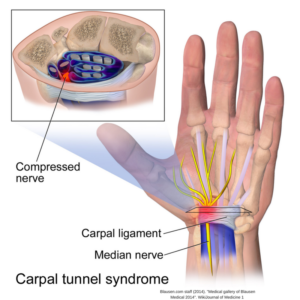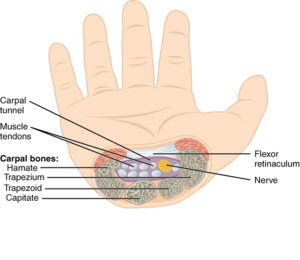Carpal Tunnel And The Wrist
The carpal tunnel of the wrist is one of the more delicate pieces of human anatomy.
The complexity of the arm, wrist, and hand blows me away.
And I feel for the many students and clients who suffer from wrist issues.
The hand and wrist are incubators for repetitive stress injuries.
So many aspects of modern culture conspire to mess with the hand and wrist (as he writes in a coffee shop hunched over his phone typing with his thumbs).
One of the main culprits for carpal tunnel issues is working at a computer. And typing for hours on end with the wrist lying flat on a desk doesn’t help.
In fact, it is a recipe for a carpal tunnel disaster.
As always my approach is the more you know about your body’s design the less likely it is to break down. So here is a brief primer on the anatomy of this amazing bit of our body.
The carpal tunnel is involved in all movements of the wrist
The wrist is the bridge between the forearm and the hand.
It consists of the ends of the radius and ulna (the bones of the forearm), the eight carpal bones, and 5 metacarpals.
There are three different joints at play in the wrist.
One joint is between the radius and the thumb side of the carpal bones.
Another joint is between the two rows of carpal bones.
And a third is between the carpal bones closer to the hand and the metacarpal bones.
There are four bones in each of the two rows of carpal bones— the scaphoid, lunate, triquetral, and pisiform are closer to the arm.
The trapezium, trapezoid, capitate and hamate bones are closer to the hand.
There are a lot of bones in the wrist and hand
Nine flexor tendons and the median nerve pass through the carpal tunnel which is essentially a narrow canal with little room to spare around its ten inhabitants.
Problems with any of the tendons can lead to a compression of the median nerve that can lead to carpal tunnel syndrome.
The carpal bones form an arch that is convex on the top side of the hand and concave on the palm side.
The tunnel created on the palm side is covered by the flexor retinaculum or transverse carpal ligament.
The flexor retinaculum attaches to the scaphoid tubercle and the ridge of trapezium on the side of the radius, and to the pisiform and hook of hamate on the side of the ulna.
Any time the wrist moves the shape and width of the carpal tunnel change.
There is movement between all of the carpal bones and as such both flexion and extension affect the available space in the carpal tunnel.
Learning and understanding this anatomy will help but the most important thing to do is to treat your wrists and hands kindly.
This means using them a lot. And changing the way you stand and walk will only help.
Standing posture and movement patterns have way more influence on the wrists than most people imagine.
Correcting them will go a long way towards supporting your wrists.
If you are going to work at a computer for long periods of time make sure to take breaks and stretch your forearms and wrists.
Do hand exercises to keep them supple.
Sit correctly when at your desk and think about keeping the wrists elevated while you type.




